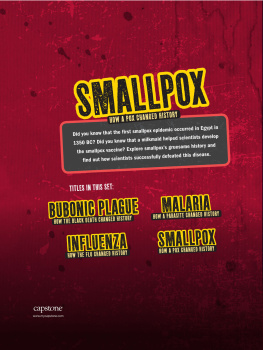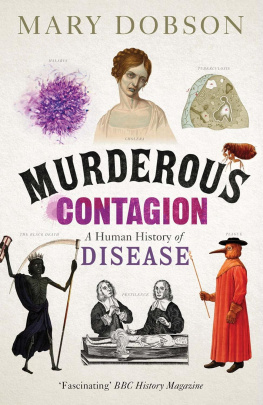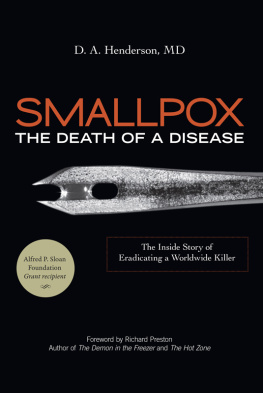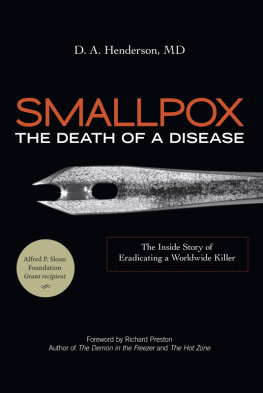On December 20, 1694, Queen Mary II of England collapsed. Flashes of pain ran through her head and down her back. She sometimes felt chilly, which caused her to shiver. At other times she sweated. Hundreds of people in London, England, were coming down with a deadly disease called smallpox. A historian at the time wrote, Smallpox was always present, filling the churchyard with corpses. Queen Mary was afraid she had come down with smallpox. She shut herself in her room at Kensington Palace. She did not want the disease to spread.
Three days later a reddish-purple color spread across Marys face. Nine doctors gathered by her bedside. Based on Marys , they thought the disease could be either measles or smallpox.
Measles is an infection that causes people to break out in rashes. Doctors hoped the disease was measles and not smallpox. Smallpox was deadlier than measles. The doctors had to wait until Mary developed more symptoms to find out which disease she had.
Mary II was the queen of England from 1689 to 1694.
FAST FACT
The smallpox virus spread very easily. People could catch it when a nearby sick person sneezed or coughed. If people breathed the air around a sick person, they could get the virus.
The next day blisters formed on Marys face, arms, hands, and feet. The doctors agreed this was smallpox. But they did not know whether Mary had a deadly form of the disease.
Doctors typically tried a few treatments on people with smallpox. One common treatment was wrapping the patient in blankets in a hot room. Doctors thought this would help the patient sweat out the disease. Some doctors tried bloodletting. This involved draining blood out of a patients body. Historical accounts do not explain the type of treatment Mary received.
Marys health soon worsened. Her blisters flattened and spread into red sores along her body. The sores turned purple and black. Red rings formed around each one. Later the sores filled with blood. The queen gasped for breath. She spit up blood.
Mary had a rare form of smallpox called hemorrhagic smallpox. This was the deadliest type of smallpox. Victims bled out from openings in the body. Mary bled from her nose, eyes, and skin. She could no longer eat, drink, or speak. Eight days after her first symptoms, Mary died.
In all forms of smallpox, blisters formed on an infected persons body.
WHAT WAS SMALLPOX?
Smallpox was one of the worlds deadliest diseases. About three out of every ten people who got it died. Smallpox was , or eliminated worldwide, in 1980. But before then the disease had killed hundreds of millions of people.
Smallpox often left scars on a persons skin.
A viruses caused smallpox. The variola minor virus caused a mild form of smallpox. People who caught this virus would usually have fevers, headaches, and backaches. They would develop rashes. Later bumps called lesions would break out on their skin. The infected person would usually recover within a few weeks. Only about 1 percent of people died from this type of smallpox.
The variola major virus was deadlier and more common than the variola minor virus. Its symptoms included fevers, headaches, backaches, and vomiting. A rash developed about four days after the first symptoms. Then the victims skin would break out in lesions. The lesions would turn into blisters. About 30 percent of infected people died from this type of smallpox. People usually died within 10 to 16 days after their symptoms first appeared. Hemorrhagic smallpox was a type of variola major smallpox. People with hemorrhagic smallpox often died five or six days after getting a rash.
FAST FACT
Another name for smallpox was the speckled monster. This is because it covered a persons body in blisters and sores.
People who survived smallpox had permanent damage. They had pockmarks, or big pits, on their skin. These were scars that disfigured a persons skin. Some people even went blind.
the variola major virus under a microscope
CHAPTER 2
THE HISTORY OF SMALLPOX
Historians believe the first smallpox Ramses V died of smallpox in 1157 BC. The Egyptians preserved the bodies of their pharaohs, including Ramses V. Scars on Ramses Vs face are still visible today. They look like smallpox scars.
FAST FACT
Among people who were never exposed to smallpox, the death rate could be as high as nine in 10 people.
THE SMALLPOX PANDEMIC
Smallpox spread around the world for thousands of years. When a disease spreads all over the world, it is called a . By AD 1000 only a few regions had not been infected by smallpox. It had not spread to Russia, Scandinavia, Iceland, North America, or South America. People who lived in infected regions, including Europeans, developed some resistance to the virus.
Pharaoh Ramses V may have died from smallpox.
European settlers brought the disease to the unaffected regions. People in these regions had never been exposed to smallpox. This meant that their bodies did not know how to fight the virus.
In 1241 a Danish ship brought smallpox to Iceland. The disease killed nearly half of the countrys population. In April 1520 a slave from Africa being held captive on a Spanish ship came down with smallpox. The ship docked in Mexico, and the virus spread throughout the region. About 90 percent of Mexicos population died from smallpox.
Smallpox killed many people in the Wampanoag tribe in Massachusetts in the 1600s.
SMALLPOX IN NORTH AMERICA
In the 1600s Dutch, English, and French settlers built Huron-Wendat community.
RED TREATMENT
The color red was once thought to have special healing powers. It was used to treat smallpox patients beginning in the 1200s. People who had smallpox slept in red bedsheets and wore red nightclothes. They thought the red cloth would warm their skin so they could sweat out the infection. In the early 1900s, a Danish doctor used red lights to try to heal smallpox patients. He called it the red treatment. He shone the light on smallpox patients. The red treatment did not work. But doctors kept using this treatment until 1920.
CHAPTER 3
SMALLPOX EXPERIMENTS
Early in the diseases history, people began to notice that no one got smallpox twice. In about 1550 Chinese doctors used this knowledge to try to fight smallpox. They crushed smallpox scabs into a powder. Then they blew it up a patients nose. The patient would get a mild form of smallpox but usually recovered. This method was called . People in China, Arabia, and Africa began to use this method.



















